High Impact Tutoring Built By Math Experts
Personalized standards-aligned one-on-one math tutoring for schools and districts
In order to access this I need to be confident with:
Parts of a circle Area of a circle Circumference of a circleSectors, arcs and segments of a circle
Here you will learn about sectors, arcs, and segments of a circle including how to identify them, their properties, and how to use them to solve problems involving angles and arcs of circles.
Students will first learn about circle math in the geometry standards in middle school and build upon that knowledge as they progress into a geometry course in high school.
What are sectors, arcs and segments of a circle?
Sectors, arcs and segments of a circle are essential parts of a circle that are formed by chords or radii of a circle. They have specific properties and unique relationships that are used to solve problems.
![[FREE] Angles Check for Understanding Quiz (Grade 4)](https://thirdspacelearning.com/wp-content/uploads/2023/08/Angles-check-for-understanding-quiz-listing-image.png)
[FREE] Angles Check for Understanding Quiz (Grade 4)
![[FREE] Angles Check for Understanding Quiz (Grade 4)](https://thirdspacelearning.com/wp-content/uploads/2023/08/Angles-check-for-understanding-quiz-listing-image.png)
Teaching sectors, arcs and segments of a circle? Use this quiz to check your grade 4 students’ understanding of angles. 10+ questions with answers covering a range of 4th grade angles topics to identify areas of strength and support!
DOWNLOAD FREE![[FREE] Angles Check for Understanding Quiz (Grade 4)](https://thirdspacelearning.com/wp-content/uploads/2023/08/Angles-check-for-understanding-quiz-listing-image.png)
[FREE] Angles Check for Understanding Quiz (Grade 4)
![[FREE] Angles Check for Understanding Quiz (Grade 4)](https://thirdspacelearning.com/wp-content/uploads/2023/08/Angles-check-for-understanding-quiz-listing-image.png)
Teaching sectors, arcs and segments of a circle? Use this quiz to check your grade 4 students’ understanding of angles. 10+ questions with answers covering a range of 4th grade angles topics to identify areas of strength and support!
DOWNLOAD FREESegment of a circle
A segment of a circle is the area bounded by a chord of a circle and the area of the circle between the two endpoints of the chord. It is essentially a portion of the circle cut by a chord.
There are two main types of segment:
- Major segment: Creates a segment where the arc length is greater than half the circumference of the circle.
- Minor segment: Creates a segment where the arc length is less than half the circumference of the circle.

You can calculate the area of segments of circles.
For example, calculate the area of the segment formed by chord AB of circle C to the nearest tenth.
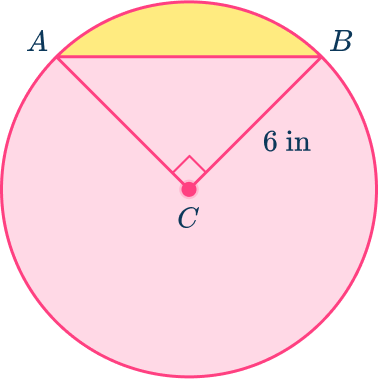
To calculate the area of the segment, find the area of the entire sector ( sector formed by radii AC and BC) and subtract the area of the triangle ( right triangle ACB).
Area of a sector: \cfrac{m A R C}{360} \times \Pi \times r^2
Note: \cfrac{m A R C}{360} means the degree measurement of the arc in degree (which is the same as the central angle) divided by the complete degree of a circle, 360^{\circ}.
In this case, the measure of the central angle ( angle ACB) is 90^{\circ} and the radius of the circle is 6 inches.
Area of a sector =\cfrac{90}{360}\times\Pi\times(6)^2=\cfrac{1}{4}\times\Pi\times{36}=9\Pi\approx{28.3}\mathrm{~in}^2
Area of triangle: \cfrac{1}{2}\times{b}\times{h}=\cfrac{1}{2}\times{6}\times{6}=18\mathrm{~in}^2
As the area of a segment = Area of a sector – Area of a triangle, the area of the segment is:
28.3-18=10.3\mathrm{~in}^2Step-by-step guide: Segment of circle
Step-by-step guide: Area of sector
Step-by-step guide: Area of a segment of a circle
Arc of circle
The arc of a circle is a portion of the edge of the circle or portion of the circumference. Similarly to segments of a circle, you can classify arcs into two different categories.
- Major arc: Arcs that are more than half the circumference of the circle.
- Minor arcs: Arcs that are less than half the circumference of the circle.

Like segments of a circle, you can calculate the lengths of arcs as a fraction of the circumference.
For example, calculate the length of minor arc FG in circle M to the nearest tenth.
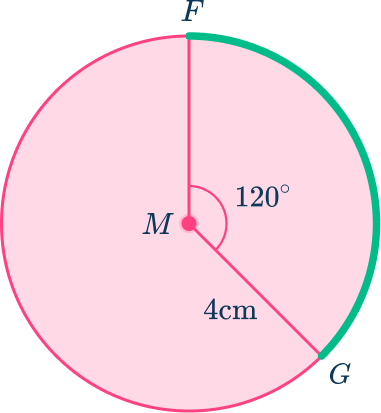
In circle M, the central angle that intercepts or subtends minor arc FG is 120^{\circ} and the radius length is 4 \, cm. To calculate the minor arc you can use the formula:
Arc length: \cfrac{m \operatorname{Arc}}{360} \times 2 \times r \times \Pi=\cfrac{120}{360} \times 2 \times 4 \times \Pi=\cfrac{1}{3} \times 8 \times \Pi=8.4 \mathrm{~cm}
Step-by-step guide: Arc of a circle
Step-by-step guide: Arc length formula
Sectors of circles
A sector of a circle is a portion of a circle created by the arc of the circle and two radii. It is like a piece of pie.
Similar to segments and arcs, sectors of circles can be classified into three categories.
- Minor sector: A sector that is less than half the circle.
- Major sector: A sector that is greater than half the circle.
- Semi-circle: A sector that is equal to half the circle.

You can calculate the perimeter of a sector and the area of a sector. For example, in circle X, find the perimeter and the area of sector ZXY.
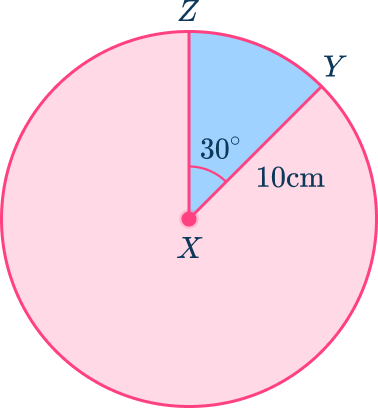
To calculate the length of the minor sector ZXY , first find the length of minor arc YZ and then add the radii lengths. In this case, the central angle is 30^{\circ} and the radii lengths are 10 \, cm.
Arc length (YZ)= \cfrac{m A R C}{360} \times 2 \times r \times \Pi=\cfrac{30}{360} \times 2 \times 10 \times \Pi=\cfrac{1}{12} \times 20 \times \Pi=5.2 \mathrm{~cm}
Perimeter of minor sector ZXY\text{:} radius + radius + arc length =10+10+5.2=25.2\mathrm{~cm}
To calculate the area of minor sector ZXY to the nearest tenth, use the formula:
Area of sector: \cfrac{m A R C}{360} \times \Pi \times r^2=\cfrac{30}{360} \times \Pi \times(10)^2=\cfrac{1}{12} \times \Pi \times 100=26.2 \mathrm{~cm}^2
Step-by-step-guide: Sector of circle
Step-by-step-guide: Perimeter of a sector
Step-by-step-guide: Area of a sector
What are sectors, arcs and segments of a circle?
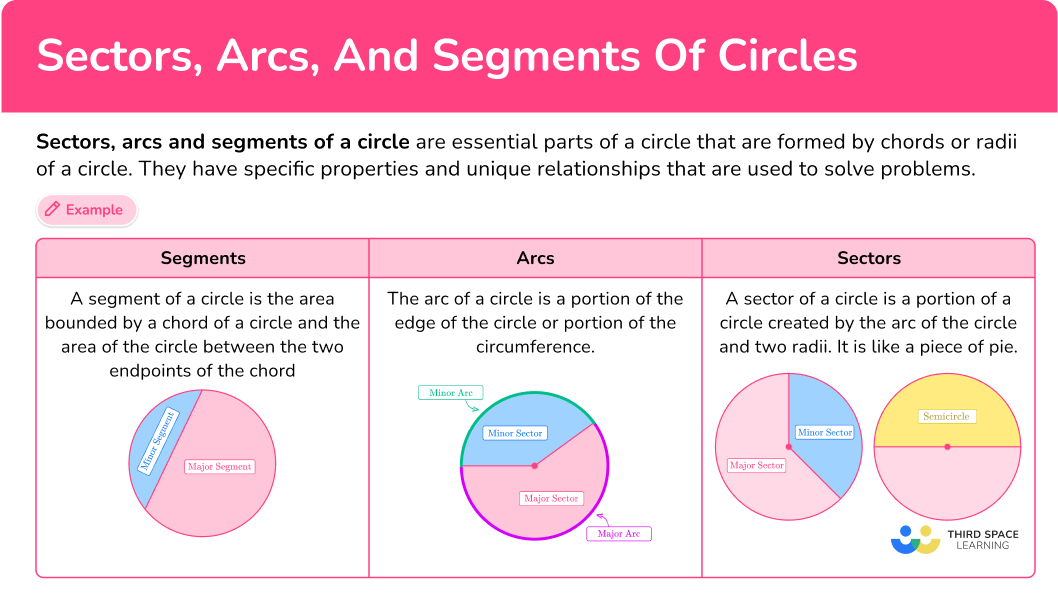
What are sectors, arcs and segments of a circle?
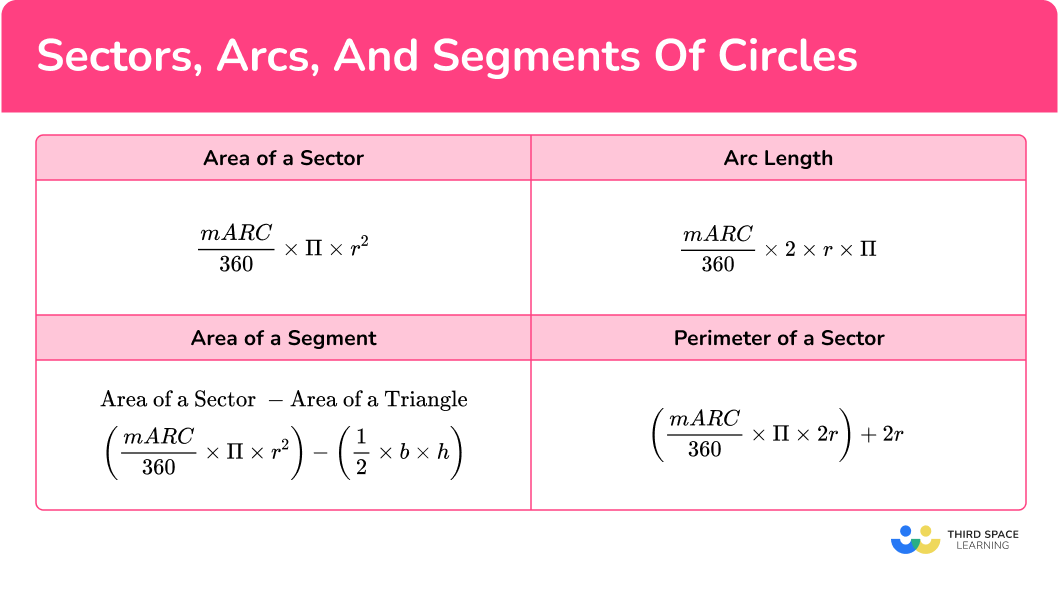
Common Core State Standards
How does this relate to high school math?
- High School – Geometry – Circles (HS.G.C.B.5)
Derive using similarity the fact that the length of the arc intercepted by an angle is proportional to the radius, and define the radian measure of the angle as the constant of proportionality; derive the formula for the area of a sector.
- High School: Geometry (HS.G.CO.A.1)
Know precise definitions of angle, circle, perpendicular line, parallel line, and line segment, based on the undefined notions of point, line, distance along a line, and distance around a circular arc.
How to answer questions on sectors, arcs, and segments of circles
There are a lot of ways to use sectors, arcs, and segments of circles. For more specific step-by-step guides, check out the individual pages linked in the “what are sectors, arcs, and segments of circles?” section or read through the examples below.
In order to solve problems involving sectors, arcs, and segments:
- Recall the formula.
- Make the calculation or provide an explanation.
Sectors, arcs, and segments of circles examples
Example 1: calculate the area of minor segment
Calculate the area of the segment pictured below to the nearest tenth.
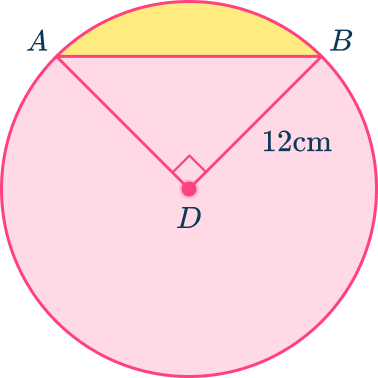
- Recall the formula.
To find the area of a segment, find the area of the sector and then subtract the area of the triangle.
In this case, the central angle that intercepts minor arc AB is 90^{\circ} , and the radius length is 12\mathrm{~cm}.
2Make the calculation or provide an explanation.
Area of sector:
\begin{aligned}&=\cfrac{m A R C}{360} \times \Pi \times r^2 \\\\ &=\cfrac{90}{360} \times \Pi \times 12^2 \\\\ &=\cfrac{1}{4} \times \Pi \times 144 \\\\ &=113.1 \mathrm{~cm}^2 \end{aligned}To find the area of triangle ADB use: \cfrac{1}{2} \times b \times h
Area of triangle ADB\text{:}
\cfrac{1}{2} \times 12 \times 12=72 \mathrm{~cm}^2Area of segment = Area of sector - Area of triangle
Area of segment =113.1-72=41.1\mathrm{~cm}^2
Example 2: calculate the area of major sector
Find the area of the major sector pictured below to the nearest tenth.
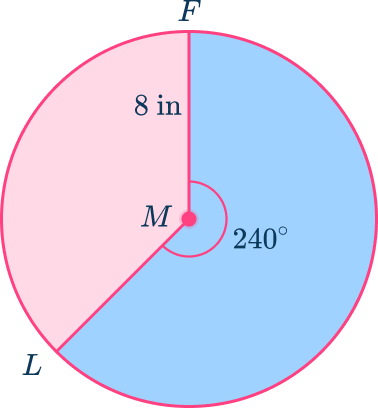
Recall the formula.
To find the area of a sector, use the formula, \cfrac{m A R C}{360} \times \Pi \times r^2
In this case, radius is 8 inches and the central angle is 240^{\circ}.
Make the calculation or provide an explanation.
Area of sector:
\begin{aligned}&=\cfrac{m A R C}{360} \times \Pi \times r^2 \\\\
&=\cfrac{240}{360} \times \Pi \times(8)^2 \\\\
&=\cfrac{2}{3} \times \Pi \times(64) \\\\
&=134.0 \mathrm{~in}^2 \end{aligned}
Example 3: calculating sector
Find the area of minor sector that has a central angle of 30^{\circ}.
Leave your answer in terms of pi.
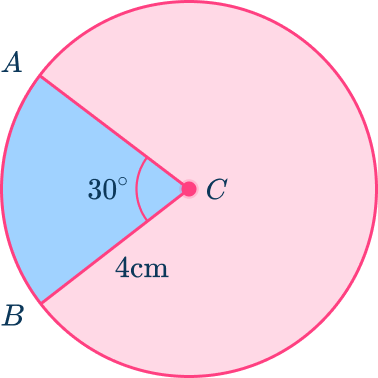
Recall the formula.
To find the area of a sector, use the formula, \cfrac{m A R C}{360} \times \Pi \times r^2
In this case, radius is 4\mathrm{~cm} and the central angle is 30^{\circ}.
Make the calculation or provide an explanation.
Area of sector:
\begin{aligned}&=\cfrac{m A R C}{360} \times \Pi \times r^2 \\\\
&=\cfrac{30}{360} \times \Pi \times(4)^2 \\\\
&=\cfrac{1}{12} \times \Pi \times(16) \\\\
&= \cfrac{16}{12} \Pi \\\\
&=\cfrac{4}{3} \Pi \mathrm{~cm}^2 \end{aligned}
Example 4: arc length
Find the length of minor arc GH to the nearest tenth.
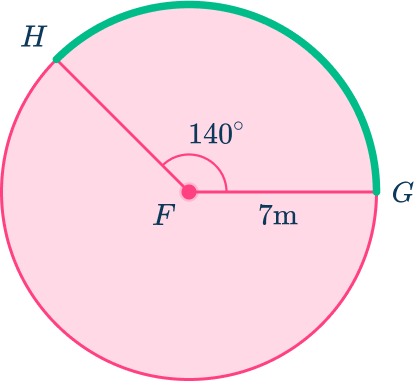
Recall the formula.
To find the arc length of minor arc GH, use the formula, \cfrac{\text { mARC }}{360} \times 2 \times r \times \Pi
In this case, radius is 7\mathrm{~m} and the central angle is 140^{\circ}.
Make the calculation or provide an explanation.
Arc length:
\begin{aligned}&=\cfrac{m A R C}{360} \times 2 \times r \times \Pi \\\\
&=\cfrac{140}{360} \times 2 \times 7 \times \Pi \\\\
&=\cfrac{140}{360} \times 14 \times \Pi \\\\
&=17.1\mathrm{~m} \end{aligned}
The length of minor arc GH is 17.1\mathrm{~m}.
Example 5: arc length
The measure of the angle at the center of the circle M is 50 degrees.
Find the length of the major arc DL to the nearest tenth.
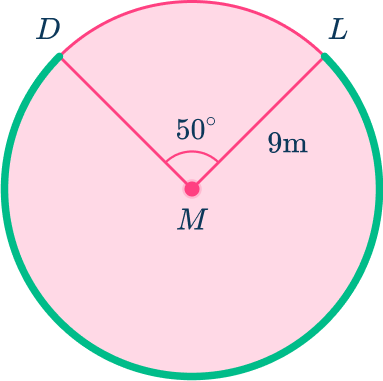
Recall the formula.
To find the arc length of major arc DL, use the formula, \cfrac{\text { mARC }}{360} \times 2 \times r \times \Pi.
In this case, radius is 9\mathrm{~m} and the central angle is 50^{\circ}.
Make the calculation or provide an explanation.
Arc length:
\begin{aligned}&=\cfrac{m A R C}{360} \times 2 \times r \times \Pi \\\\ &=\cfrac{50}{360} \times 2 \times 9 \times \Pi \\\\ &=\cfrac{50}{360} \times 18 \times \Pi \\\\ &=7.9\mathrm{~m} \end{aligned}
The length of major arc DL is 7.9\mathrm{~m}.
Example 6: arc length
The arc length of a minor arc of a circle with a central angle of 60^{\circ} is 8\Pi\mathrm{~inches}, find the radius of the circle.
Recall the formula.
When working with arc length, the formula to use is:
Arc Length =\cfrac{m A R C}{360} \times 2 \times r \times \Pi
In this case, the arc length is 8\Pi and the central angle is 60^{\circ}. Substitute those values into the equation to find the radius length.
Make the calculation or provide an explanation.
Arc Length =\cfrac{\operatorname{mARC}}{360} \times 2 \times r \times \Pi
\begin{aligned}8 \Pi&=\cfrac{60}{360} \times 2 \times r \times \Pi \\\\
8&=\cfrac{1}{6} \times 2 \times r \\\\
4&=\cfrac{1}{6} \times r \\\\
24&=r \end{aligned}
The radius of the circle is 24 inches.
Teaching tips for sectors, arcs and segments
- Instead of relying on worksheets for students to practice skills, consider interactive activities for student practice. Provide students with real-world examples so the concepts are relevant to them.
- Use technology to allow students to interact with circles in a different way. There are many educational apps and interactive websites that offer simulations and exercises that focus on problem solving and lead to deeper understanding.
- Use investigative type activities so that students can explore circle math concepts.
Easy mistakes to make
- Confusing the sector and segment of a circle
The sector of a circle is a portion of the area of the circle whereas a segment is part of a sector minus the triangle. You can relate it to pizza, a sector is like a piece of pizza and a segment is like the crust of the pizza.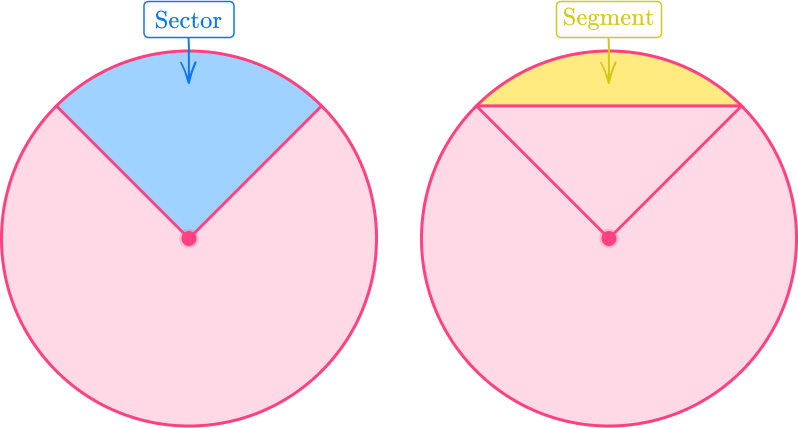
- Using the diameter instead of radius to calculate the area of a sector or finding the area of a segment
Like when you find the area of a circle, it is the radius dimension that is needed to calculate not the diameter. If you are given the diameter length, divide it by 2 to find the radius length.
- Thinking the arc length is a squared dimension
The arc length of a circle is part of the circumference, so it is a one dimensional measurement, not a square dimension like area.
Sectors, arcs, and segments practice problems
1. Find the area of the minor sector in circle C. Round your answer to the nearest tenth.
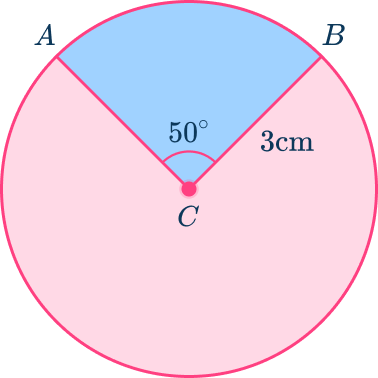




To find the area of a sector use the formula, \cfrac{m A R C}{360} \times \Pi \times r^2.
In this case substitute 3 for the radius and 50^{\circ} for the arc measurement.
\begin{aligned}\text { Area of sector }&=\cfrac{50}{360} \times \Pi \times 3^2 \\\\ &=\cfrac{5}{36} \times \Pi \times 9 \\\\ &\approx 3.9 \mathrm{~cm}^2 \end{aligned}
2. Find the arc length of minor arc AB.
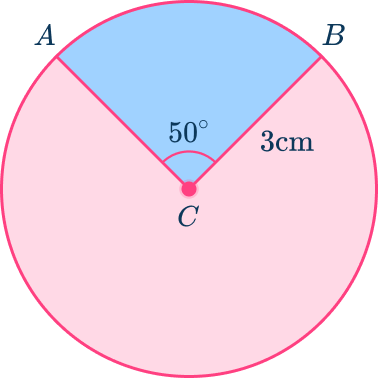




To find the arc length of minor arc AB, use the formula,
Arc Length =\cfrac{m A R C}{360} \times 2 \times r \times \Pi
In this case, substitute in 3 for the radius and 50^{\circ} for the arc measurement.
\begin{aligned}\text { Arc Length }&=\cfrac{50}{360} \times 2 \times 3 \times \Pi \\\\ &=\cfrac{5}{36} \times 6 \times \Pi \\\\ &\approx 2.6 \mathrm{~cm} \end{aligned}
3. Find the length of the diameter (to the nearest whole number) of circle H where the length of arc FG is approximately 9.6\mathrm{~inches}.
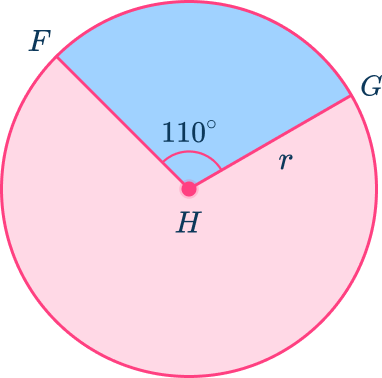




Using the formula, Arc Length =\cfrac{\operatorname{mARC}}{360} \times 2 \times r \times \Pi, substitute in the value 110^{\circ} for the arc measurement and 9.6 for the arc length in order to solve for r.
\begin{aligned}\text { Arc Length }&=\cfrac{m A R C}{360} \times 2 \times r \times \Pi \\\\ 9.6&=\cfrac{110}{360} \times 2 \times r \times \Pi \\\\ 4.8&=\cfrac{11}{36} \times r \times \Pi \\\\ 5.00&=r \end{aligned}
The radius is 5\mathrm{~inches}. As the diameter is twice that length, the diameter of the circle is 10\mathrm{~inches}.
4. Find the area of the segment of the circle highlighted below, round answer to the nearest tenth.
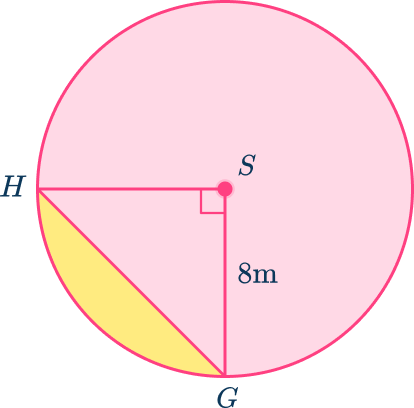




To find the area of a segment of a circle, find the area of the sector and subtract away the area of the triangle.
In this case the sector has a central angle of 90^{\circ} and radius length of 8 \, m.
Use that information to find the area of the sector using the formula, \cfrac{m A R C}{360} \times \Pi \times r^2.
\begin{aligned}\text { Area of sector }&=\cfrac{90}{360} \times \Pi \times(8)^2 \\\\ &=\cfrac{1}{4} \times \Pi \times 64\\\\&=50.3 \mathrm{~m}^2 \end{aligned}
The area of the triangle is \cfrac{1}{2} \times b \times h where the base and the height of triangle GSH is 8 meters.
Use that value to find the area of the triangle.
\begin{aligned}\text { Area of triangle }&=\cfrac{1}{2} \times 8 \times 8 \\\\ &=\cfrac{1}{2} \times 64 \\\\ &=32 \mathrm{~m}^2 \end{aligned}
To find the area of the segment of the circle, subtract the two areas.
\text { Area of segment }=50.3-32=18.3 \mathrm{~m}^2.
5. Circle B has a central angle ABC of 160^{\circ}\text{;} the radius is 4\mathrm{~in}, \, BD is the perpendicular straight line segment to AC and measures 1.5\mathrm{~in}, and chord AC is 6\mathrm{~in}. Find the area of the segment in the circle below. Round your answer to the nearest tenth.
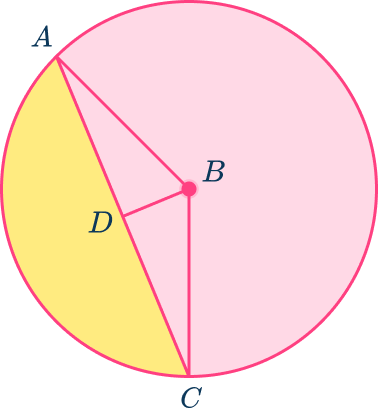




To find the area of a segment of a circle, find the area of the sector and subtract the area of the triangle.
In this case the circle has a radius of 4\mathrm{~in} and the central angle of the sector is 160^{\circ}. Use those values to find the area of the sector.
\begin{aligned}\text { Area of sector }&=\cfrac{\operatorname{mARC}}{360} \times \Pi \times r^2 \\\\ &=\cfrac{160}{360} \times \Pi \times(4)^2 \\\\ &=\cfrac{4}{9} \times \Pi \times 16 \\\\ &=22.3 \mathrm{~in}^2 \end{aligned}
Next, find the area of triangle ABC which has a base of AC and perpendicular height BD ( the angle ADB is a right angle ).
\begin{aligned}\text { Area of triangle }&=\cfrac{1}{2} \times 1.5 \times 6 \\\\ &=3 \times 1.5 \\\\ &=4.5 \mathrm{~in}^2 \end{aligned}
\begin{aligned}\text { Area of segment }&=\text { Area of sector }- \text { Area of triangle } \\\\ &=22.3-4.5 \\\\ &=17.8 \mathrm{~in}^2 \end{aligned}
6. A circle has a sector that is 240^{\circ} of the circle and has an area of 6 \Pi \mathrm{~cm}^2. Find the length of the radius of the circle.




In this case, use the formula for the area of a sector,
\text { Area of sector }=\cfrac{m A R C}{360} \times \Pi \times r^2
Substitute the given information into the formula, the inscribed angle 240^{\circ} for the measure of the arc and 6\Pi for the area of the sector.
\begin{aligned}6\Pi&=\cfrac{240}{360} \times \Pi \times r^2 \\\\ 6&=\cfrac{2}{3} \times r^2 \\\\ 9&=r^2 \\\\ 3&=r \end{aligned}
The radius of the circle is 3\mathrm{~cm}.
Sectors, arcs and segments of a circle FAQs
No, the arc length is part of the circumference which is the distance around a circle.
The measurement of the arc in degrees represents the fractional part of the complete degree of a circle which is 360^{\circ}.
So, the measurement of an arc will be less than 360^{\circ}.
No, there are times you will be given the arc measurement or the central angle measurement in radians instead of degrees.
If you are given the central angle in radians, the formula to use to find arc length is s=\Theta \times r and to find the area of the sector when given the angle in radians is A=\cfrac{\Theta}{2} r^2.
In a precalculus class, radian measures are more often given than degree measurements.
If the triangle is not a right triangle, you will be given enough information to find the height and the base to calculate the area.
For example, you can use trigonometry to find missing dimensions.
The angle at the center of a circle is twice the measure of the angle at the circumference of the circle subtended by the same two vertex points that lie on the circumference.
The measure of an angle inside a circle can be determined using circle theorems, such as the inscribed angle theorem.
Still stuck?
At Third Space Learning, we specialize in helping teachers and school leaders to provide personalized math support for more of their students through high-quality, online one-on-one math tutoring delivered by subject experts.
Each week, our tutors support thousands of students who are at risk of not meeting their grade-level expectations, and help accelerate their progress and boost their confidence.

Find out how we can help your students achieve success with our math tutoring programs.
[FREE] Common Core Practice Tests (3rd to 8th Grade)
Prepare for math tests in your state with these 3rd Grade to 8th Grade practice assessments for Common Core and state equivalents.
Get your 6 multiple choice practice tests with detailed answers to support test prep, created by US math teachers for US math teachers!